Subtotal: $
Checkout-

Tim Keller: New York’s Pastor
-

What Is Time For?
-

Poem: “South Head, a Wild Surmise”
-

Poem: “Lammergeier”
-

Poem: “World Within”
-

When Love Seems Impossible
-

Places to Think with Neighbors
-

Letters from Readers
-

Covering the Cover: The Enemy
-

Thanksgiving Starts in September
-

The Monsignor versus the Fascists
-

Do Activists Need Enemies?
-

The Making of Martyrs
-

Visions of the Kingdom
-

Foolhardy Wisdom
-

Tough Love on the Mount
-

Walls behind Bars
-

My Mind, My Enemy
-

Demining the Sahara
-

Just Doing What Christians Do
-

Hating Sinners
-

Students Brave the Heat
-

The Witching Hour
-

Enemy Lovers
-

How God Sees Us

Macedonia Morning
A decade before the protest movements of the sixties, Staughton Lynd and other visionaries were laying a foundation in the hills of Georgia.
By Dana Wiser
August 25, 2023
Staughton Lynd, though he would never admit it, is one of the visible saints of the modern American left.… Nonviolence was the kernel of almost everything good in the New Left. No one, save King himself, seemed to live and breathe it better than Staughton Lynd.” —Paul Buhle, the Nation, 1997
Staughton Lynd was at the pinnacle of his fame when he sat quietly in his Chicago living room, considering his future. The 1960s were flaming out in violence. His friends were calling police “pigs,” militarizing protests, and employing hatred in the class struggle. The movements he led were taking directions he disagreed with. “I decided that day to give up my place on the speaker’s platform and remain true to my beliefs,” he told me in 2015. “I opted for obscurity.”
Lynd died November 17, 2022. Obituaries noted that he had taught history at Yale, directed civil rights projects, and shaken up international politics. What beliefs would eclipse such accomplishments?
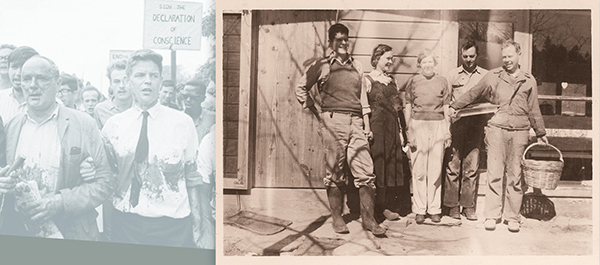
Left: Dave Dellinger, Staughton Lynd, and Robert Moses lead a protest march, August 6, 1965.
Right: Staughton and Alice, Alma Kneeland, Richard Mommsen, and Art Wiser, ca. 1956.
All images courtesy of Dana Wiser and the Lynd family.
The answer lies in a secluded Appalachian valley. What the New York Times obituary passes off as three years in a “Quaker commune in northern Georgia” was key to Lynd’s formation. Along Shoal Creek in Habersham County, a few young pacifists gathered after World War II and idealistically set out to build a new society. “The values to which we committed ourselves at Macedonia are the values we sought to live by thereafter,” wrote Staughton with his wife, Alice, in their 2009 memoir Stepping Stones.
Macedonia Cooperative Community began as the brainchild of Morris Mitchell, a professor at Columbia University’s New College who convened a series of Quaker work camps to benefit poor mountain folk. One project was to start a dairy herd. My father, Art Wiser, traveled from Ithaca, New York, during the summer of 1939 to pitch in. One of his fellow participants in the work camps was my mother, Mary Raecher, daughter of a western New York dairy farmer, whom he had met at Cornell. They married shortly after the attack on Pearl Harbor.
Not all of the Greatest Generation fought in World War II. Of the conscientious objectors (COs) who refused to bear arms, twelve thousand did unpaid work of “national importance” in Civilian Public Service (CPS) camps, while six thousand went to prison. My father did both.
The urge to build a society that wouldn’t lead to war propelled many COs and their families into intentional communities after the war. From my parents I heard many stories about those years: How my mother and another CO’s wife kept the dairy going, milking twice a day while their husbands were at CPS camps. How my father rebelled at life in camp and went AWOL to milk the cows too. How Morris Mitchell reassured my father after Nagasaki that the feds wouldn’t bother him anymore, and how that night an FBI agent and a sheriff’s posse hauled him out of bed and patted him down for weapons. How Dorothy Boddie, later Mommsen, a refined Southern girl, demanded to know if there were any more “gentlemen” out there after yet another lawman had stepped over her sleeping on the porch to arrest the pacifist inside.
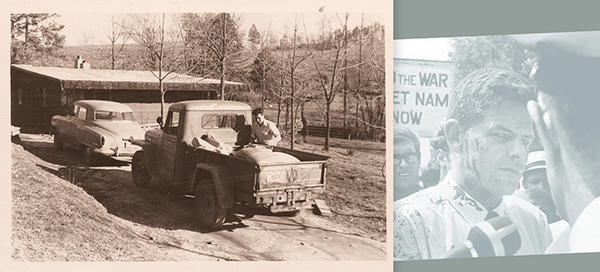
Left: Staughton outside the Community Playthings shop, ca. 1956.
Right: Staughton being interviewed, August 6, 1965.
More idealists found their way to Macedonia. They built cabins and shared the scanty living provided by the dairy and the worn-out farmland. After several business ventures failed, two teachers visiting from Atlanta suggested they make wooden toys, and in 1947 the Macedonia community started making unit blocks in a living room. Soon the workshop expanded into a chicken barn, where primitive woodworking machines turned out a growing line of children’s toys.
Meanwhile, new families were welcomed and babies born. Child-rearing and education were hot issues. My parents sent my two older siblings to the one-room local school where Miss Ruby – not a pacifist – taught the three Rs with the help of a hickory switch. Unsurprisingly, some Macedonia parents wanted their own school. Personality conflicts arose and some families left, embittered. But the community also supported each other through the last days of an elder and the tragic deaths of two young children. When my parents’ house burned down, they were welcomed into another member’s home.
The endeavor had exceeded Morris Mitchell’s original vision of economic uplift for the neighborhood and in 1948 he agreed to relinquish the project, deeding over the land to the young idealists on generous terms.
Macedonia hosted emissaries from the Bruderhof, then living as refugees in Paraguay due to their objection to war. The groups regarded each other highly, and in 1953 it looked like they might merge. But the Christian basis of the Bruderhof irked several agnostic Macedonians. Ultimately, half of Macedonia – three families – moved north to help found the first American Bruderhof, Woodcrest, in Rifton, New York. The break was amicable, with Macedonia’s assets and debts divided in two, down to the woodworking machinery and the silverware. Each group’s concern was that the other was well provided for. The woodworking business, Community Playthings, was to be carried on as a joint venture, with sales and manufacturing in both communities and a single mail-order catalog.
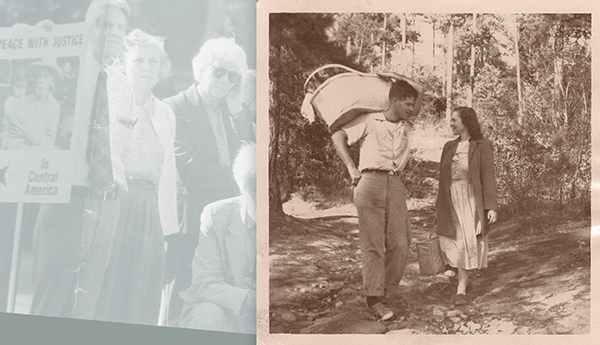
Left: Demonstrating for justice in Central America, ca. 1980.
Right: The Lynds in 1955.
By June 1954, three families remained in Macedonia, determined to continue the community according to its original humanist ideals: Richard and Dorothy Mommsen with two children, Art and Mary Wiser with four, and Ivan and Alma Kneeland. Staughton and Alice Lynd visited in August 1954 and returned in November to stay.
Staughton Lynd’s parents were Robert and Helen Lynd, authors of the influential 1929 sociological study Middletown. He and Alice met in 1950 at Harvard and Radcliffe and married within the year. In 1953 he was drafted, and, not wanting to fight, pursued basic training as a medic. But prompted by Senator Joe McCarthy’s hearings, the Army was purging draftees suspected of communism. Based on purported Marxism in Staughton’s college papers and his mother’s professional career, he was discharged as “undesirable.” Soon after, Staughton and Alice found their way to Macedonia.
The Lynds’ daughter Barbara was born that first year. Hearths and tables were shared, and childcare, too. In a letter, my mother wrote, “We feel together the power of what has got hold of us – the naked truth which will be lived, which we cannot control.”
It was a hardscrabble, simple life, as reflected in this poem Staughton wrote at the time:
Macedonia morning.
High on a pasture
In the dark,
Wool cap pulled above one ear,
Listening for cowbells.
Richard Mommsen returned home late one night with a donated wood planer in the back of his truck. The next morning, Ivan Kneeland chained the heavy machine to an overhead beam and drove the truck out from underneath, intending to lower the planer to the ground. The chain broke and the planer fell and cracked. Staughton was sure this would end the community, but no one seemed too upset. Stuff happened in Macedonia – accidents, illness, fires, friends leaving – but that didn’t mean the end of their life together.
Staughton and Alice turned to Art and Mary for advice in the early years of their marriage. One evening in the dairy, the milking done, Staughton and Art talked about commitment. Staughton listened, amazed, as Art declared that if he had to choose between his calling and his marriage, he would choose Macedonia over Mary.
But competing commitments threatened the community. Business collaboration between the Bruderhof and Macedonia was bumpy. Religion, or its lack, kept derailing decisions. Finally one day Macedonia broke into crisis mode when Staughton chose to read aloud from The Man Who Died by D. H. Lawrence, a profane account of Christ’s resurrection, at the common lunch table. Alma Kneeland, the sole churchgoer in the community, left the room in tears.
In Macedonia fashion, the members intended to talk things out and seek together for the truth. Their reading list spanned the Gospels, the Bhagavad Gita, and the Koran. Three months and seven chapters of Luke later, they were changed. Every Macedonia member was shaken. Someone drove forty-five minutes to the public phone in Clarkesville, across streams by ford and rickety bridge, and called the Bruderhof community at Woodcrest to beg that pastor J. Heinrich Arnold and his wife, Annemarie, drive down from New York.
Heinrich later described how Art “suggested that a group be formed around Jesus. People’s faces became pale and shocked. Staughton was as though paralyzed. After a while he said, ‘I feel lost. I feel an urge to put up the banner of truth anew and to call people around it. The truth remains even though people [he was looking at Art] become unfaithful.’”
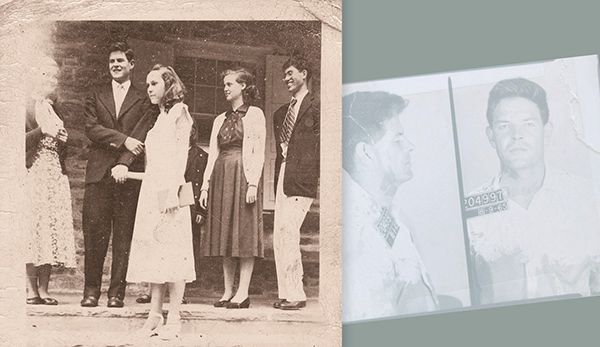
Left: Staughton and Alice married in 1951.
Right: Mug shot of Staughton, arrested on August 9, 1965.
When Staughton recalled this incident to me, he confirmed that it was the discussion in the dairy that he was remembering: “I did not take this as a legalistic commitment but as a personal promise that Art later broke.” His mentor and dear friend had betrayed him.
In a few days all the members at Macedonia agreed to give the property to the Bruderhof and seek toward a membership commitment. Staughton’s acquiescence testified to the depth of relationship the Lynds had found with their Macedonia companions.
The Lynds pitched in anew at Woodcrest. Staughton taught school, and their son Lee was born. But without a shared basis of faith it couldn’t last. Staughton and Alice agreed to separate to let each seek his or her “best light.” With their two children, Alice remained at the Bruderhof while Staughton spent nine “strange” months alone in New York City. Ultimately the family was reunited in the “hard, cold, capitalist world,” as they called it. From then on, the couple was inseparable.
The Lynds’ few short years at Macedonia and Woodcrest informed the rest of their lives. As Staughton wrote in Living Inside Our Hope (1997):
The qualitatively different atmosphere of human relationships that we encountered at Macedonia has been our objective ever since. We found it again, to some extent, in the Southern civil rights movement, which sometimes called itself “a band of brothers and sisters standing in a circle of love”; in the practice of solidarity by rank-and-file workers; and in Latin American notions about “accompanying” one another in the search for “el reino de Dios,” the kingdom of God on earth. We found it in these other places because we were looking for it; because, after Macedonia, we knew it could happen.
Staughton’s dissertation on democracy and class conflict in the Revolutionary War attracted Ivy League professorship offers. Instead he taught at Spelman College, a historically black school for women. Back in Georgia again, the Lynds sought out the civil rights movement. Staughton was invited by the Student Nonviolent Coordinating Committee (SNCC) to direct its Freedom Schools, a project concurrent with its 1964 Freedom Summer voter-registration drive.
In 1964 Yale offered Staughton an assistant professorship in history, and he taught there for three years. But his academic career came to an end when he visited Hanoi in 1966–67 on an unauthorized peace mission. Yale dropped him and academic offers elsewhere evaporated due to an FBI blacklist.
As the peace movement turned violent, Staughton deliberately gave up his leadership, and the Lynds moved to Chicago. Both became lawyers to more effectively help workers neglected by both corporations and the historic unions. They collected oral history “from the bottom up,” recording meetings of steelworkers and nurses, electric linemen and retirees.
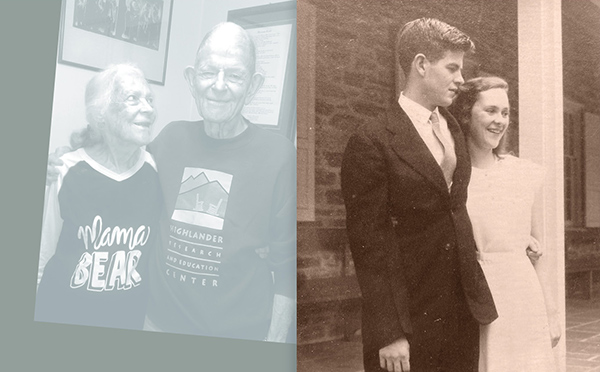
Left: Celebrating sixty-eight years of marriage in 2019.
Right: Staughton and Alice at their wedding in 1951.
In 1976, Staughton and Alice moved to Youngstown, Ohio, where prisons had replaced the steel mills. “Accompanying” the powerless led them to public defender work, to Central America, and to Palestine. After a prison riot and standoff at nearby Lucasville in 1993, several prisoners were arbitrarily convicted of the murder of a guard. The Lynds came to their defense and found themselves helping death-row inmates, to whom they came to be known as Scrapper and Mama Bear.
Soon Mama Bear was behind bars herself, in contempt of court: Alice had a prison client who confessed to a murder committed during the uprising. The confession was protected under attorney-client privilege, but other lawyers exploited it and subpoenaed Alice to testify. As a Quaker, she could not participate in actions that would put anyone on death row, and refused to provide “snitch testimony.” She was prepared to face prison indefinitely – and then her client released his privilege and authorized her to testify. He couldn’t stand the thought of his plucky seventy-five-year-old lawyer incarcerated.
Staughton went to fetch Alice from jail. As he entered through the crowd of supporters he heard his wife singing. She had kept her spirits up with the old Quaker hymn “How Can I Keep from Singing” – “no storm can shake my inmost calm while to that rock I’m clinging” – and “Dona Nobis Pacem.”
The Lynds wrote and edited many books, starting with Staughton’s Nonviolence in America (1966) and including Alice’s We Won’t Go (1968). Rank and File, drawn from the workers’ oral histories they assembled, went through four editions.
They also kept in touch with their old friends at the Bruderhof. The other former Macedonians were believers now, and Staughton a self-styled existentialist. Old differences continued to resurface, but they never stopped corresponding.
In early 2015 my wife, Maureen, and I were driving through Niles, Ohio, and enjoyed Staughton and Alice’s hospitality at their modest ranch house, outfitted with hand-me-down appliances and decades’ worth of activist memorabilia. The Lynds welcomed us with true Macedonia camaraderie. On the kitchen table was an artifact of our childhood, a Woodcrest songbook. The corners of its antique mimeographed pages were worn round by use. Staughton and Alice wanted to sing the old songs together.
Staughton once told me, “I try to live by Matthew 25 to the extent that I am able to do so.” He understood that fundamentally everyone’s calling is to love the hungry, the sick, the stranger, the prisoner. He was heartened to see that the vision that had taken root in him on those frosty mornings on Georgia hillsides and that led him to decades of fruitful antiwar, civil rights, and labor activism was continuing to bear fruit in other lives, like mine, indelibly shaped by the ventures dared at Macedonia. Planers can break and houses burn. But along Shoal Creek my mother’s daffodils have spread into the woods from her burned-down threshold. They bloom again every spring.
Already a subscriber? Sign in
Try 3 months of unlimited access. Start your FREE TRIAL today. Cancel anytime.




































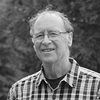
David Hollinger
I met Staughton Lynd a couple of times, including once when we were together on a panel at a meeting of historians. He behaved with grace and humility. Certainly he was a man of genuine character. Ed.: Dr. Hollinger is Preston Hotchkis Professor Emeritus at UC Berkeley. Author of Protestants Abroad: How Missionaries Tried to Change the World but Changed America.
Tom Brookshire
What a wonderful article! I was overwhelmed to read of Macedonia, the place of my earliest memories, and the people, their visions and activism that so influenced my life, even though I have not always been consciously aware of the sources of that inspiration. I'll share this with my mother, Kathy. Thank you!
Thomas Angell
The social gospel emphasis of the Lynds was the world view I grew up on among liberal Quakers. Although I have spent my entire professional career engaged in quintessential social gospel work as a public defender and have had the opportunity to speak into many lives, I am absolutely convinced that the real power is not in the social gospel but in the actual gospel—the witness, ministry, sacrificial death and bodily resurrection of Jesus Christ. As we have seen in communist/Marxist movements, there is this impulse to coerce, threaten, imprison, kill those who stand in the way of the “progressive” cause of the day, whereas the gospel of Jesus Christ teaches that change comes one heart at a time as we learn with the help of the power of the Holy Spirit to die to ourselves and live for Christ. We would rather suffer ourselves than force others to accept our truths.
Barbara Lynd
This article captures the essence of who my father was and of my parents' life together with more insight than any other "obituary" that I have read. it also helps me to understand my family heritage more fully. The only change that I would have suggested is the definition of my father as a self-styled existentialist. The emphasis certainly would be more on the self-styled. As my mother told me, he considered himself to be a Marxist Quaker. I think he had a longing for truth that is closer to religion than the philosophy of an existentialist. And he had tremendous concern for how that truth was lived out in relation to human relationships, “…love of neighbor…”, lived out in the personal, communal, political, and economic spheres. Ed.: The writer is Staughton Lynd’s eldest daughter, born in Macedonia.
Francis Wardle
I am very grateful for this article. I think it should be required reading for every young person living in the Bruderhof! It clearly describes the searching and sacrifices of those seeking community at that time; it also describes the origins of the now very successful enterprise of Community Playthings. Finally, it details the interface between the Civil Rights Movement of the 1960s and the search for communal living. Thanks Dana!
Jesiah Waldner
This article is long-awaited, historical masterpiece of the down-to-earth Gemeinschaft efforts and achievements of Staughton Lynd and his fellow brothers and sisters. This crucial time in history cannot be forgotten, written down for us to read and contemplate. Thank you, Dana, for writing this, you are a true friend!
Phil Bence
What a wonderful story!
DeVonna Allison
Thank you, Dana, for sharing this article, as a testament to two lives well-lived. For many years I have longed for community with people who share my liberalist leanings. I read of groups, like the Macedonians and especially Bruderhoffers and I am touched with their sense of shared commitment and purpose. I admire and respect them. I appreciate this article.